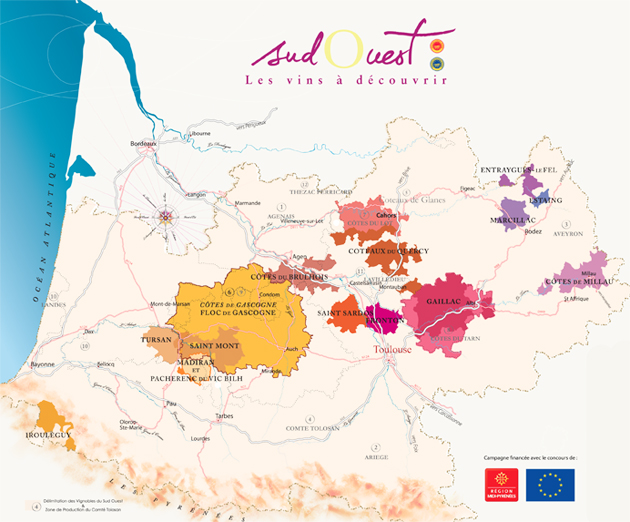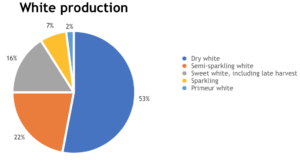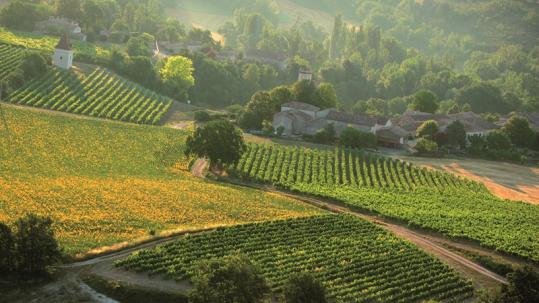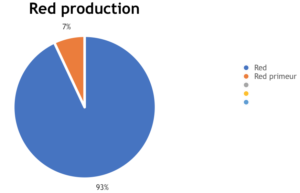Discover the wines of Gaillac and learn the essentials of the terroir with our Fast Facts guide to this region in South-west France. Read on for the essentials of terroir (the soil types, climate, average temperatures, rainfall, longitude and latitude, and altitude); the main grape varieties used for different wine varieties; the viticultural methods, age of vineyards and vine training systems; the winemaking techniques, wine styles and tasting notes; and the production area in size and number of producers.
Where is Gaillac anyway?
South-west France, about 50km northeast of Toulouse. It’s located on the Tarn river, which connects with the Garonne and so to the historical port at Bordeaux.

The Essentials of Terroir
Climate & Landscape
This is an area of many influences, so the climate can vary greatly. There are mountains to the east, the Mediterranean brings warmth from the south, while the Atlantic to the west brings a maritime influence with moisture. There is also the Autan wind from the south-east, bringing warm, dry air from Africa.
Temperature
The temperature here averages 13.1 °C during the year.
Rainfall
Precipitation here averages 732 mm annually.
Soils and altitude
The right bank of the river Tarn has clay and limestone hills.
The left bank is lower-lying and has alluvial or clay soils.
The Plateau Cordais has limestone soils and can be up to 300 metres above sea level.
Noyau du Cunac has schist soils.
Longitude
1.89 E
Latitude
43.90 N
Viticulture Facts & Vineyard Management
Irrigation
No irrigation
Grape Varieties & Winemaking Styles
While the international superstar grapes such as Sauvignon Blanc and Cabernet Sauvignon have been planted and found their way into some of the blends here, it is its indigenous varieties that makes Gaillac wine so interesting.
Whites:
Mauzac
A star grape both in Gaillac and Limoux, both of which were producing lightly sparkling wines long before Champagne. This is because it’s a very late ripener and so the fermentation process traditionally began further into autumn than that for other varieties. Sometimes the temperatures in the cellar would drop and the fermentation would stop while there was still sugar in the wine. The wine would be bottled and then, as temperatures rose in spring, the fermentation would start again, right there in the bottle, producing a light sparkler through a system now known as méthode ancestrale. Gaillac still makes wines in this way to this day, as well as traditional method sparkling.
Mauzac has green apple aromas and is also used in a wide range of still wines, from dry to sweet, usually blended with Len de L’El.
When harvested overripe, it has aromas of quince, honey and candied fruit.
Len de L’El (aka Loin de L’Oeil)
This adds power and weight into white blends (15% of white Gaillac) but is low in acidity. Subtle in dry wines but brings tropical and dried fruit notes and honey to sweet wines.
Muscadelle
Ondenc
With its golden, juicy berries makes subtle and refined dry whites and concentrated and complex late harvest styles.
Sauvignon Blanc is added to some blends.
White wine styles:
- dry white blends
- sweet and late harvest blends
- dry white perlé (a semi-sparkling style)
- méthode ancestrale (lightly sparkling) from Mauzac.
- Primeur white – a crisp, dry white for early drinking.
Reds:
Braucal (aka Fer or Pinenc in Madiran)
This is the most grown red in Gaillac. It’s a concentrated, characterful red with lots of tannins and is used in blends across SW France. It adds fruity aromas like redcurrants, blackcurrants and raspberries.
Duras
Often blended with Fer and provides wines with good structure and acidity with fine tannins and spicy flavours.
Syrah
Gamay
Cabernet Sauvignon
Wine styles with black grapes:
- Rosé
- Red blends
- Primeur red – a refreshing, fruity red from Gamay made for early drinking. Released early in the same way as Beaujolais Nouveau.

Production Area
2961 hectares (2012)
Number of Producers
100 independent producers and 3 cooperative cellars.
Annual Production
155,000 hl per year
Gaillac Rosé – 2.5 million bottles (75cl)
Gaillac White – 6.8 million bottles
Gaillac red – 10.7 million bottles
White production – breakdown
Main Regions
The Left bank of the river is an area of 30 km of alluvial terraces. It produces powerful, robust reds from Duras and whites from Loin de l’Oeil. It also has a late harvest style.
The right bank is a large area of rolling hills with clay and limestone. especially good at whites from Mauzac which range from dry, elegant and supple wines with a long finish through to rich and fragrantly sweet wines. It also produces fruity, spicy reds from Braucal (Fer).
The most northerly area of Gaillac is the Plateau Cordais, which is also at 200-300 metres above sea level. An area of shallow limestone with west-facing slopes, it produces characterful wines: floral and fruity whites, balanced, fragrant reds and fragrant, light and fruity rosés.
Le Noyau de Cunac has acidic shale on gravel-like clay. This is an area known for reds which are fruity, with mild tannins, based on Gamay, with Duras and Braucal. This area produces Gaillac Primeur, a light, early-drinking wine in the same category as Beaujolais Nouveau.
Interesting Facts
This is a region of firsts, despite big brother Bordeaux’s efforts to keep it down over the centuries. It was one of France’s first wine-producing areas, dating back to Roman Gaul; it established strict viticultural and wine production regulations 800 years before AOCs were set up in France; it was home to what is likely to have been the first ever wine brand (Vins du Coq) and, together with Limoux, Gaillac was making sparkling wine by 1680, long before Champagne. This varied wine region has a long and prestigious history and it is well worth trying some of its wines.
Useful resources:


